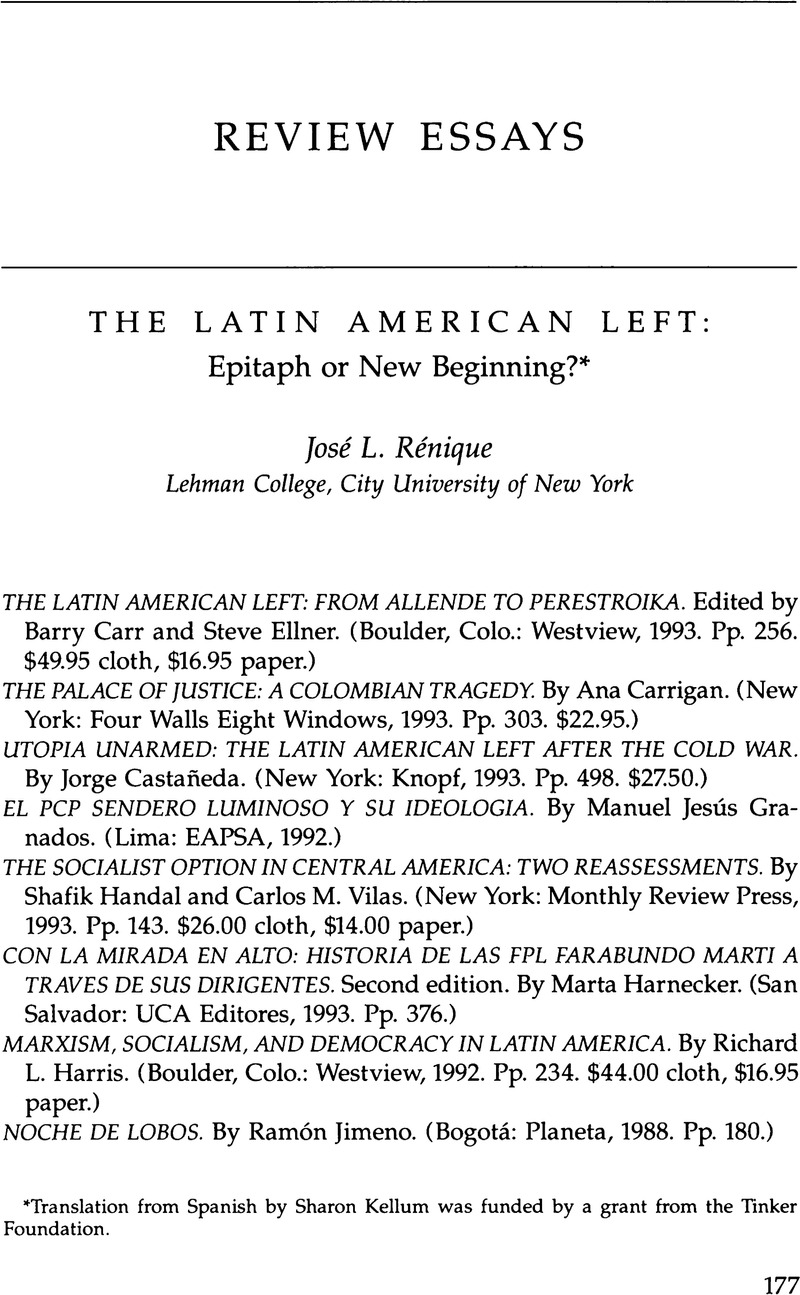Article contents
The Latin American Left: Epitaph or New Beginning?
Review products
Published online by Cambridge University Press: 05 October 2022
Abstract

- Type
- Review Essays
- Information
- Copyright
- Copyright © 1995 by the University of Texas Press
Footnotes
Translation from Spanish by Sharon Kellum was funded by a grant from the Tinker Foundation.
References
1. Partido Comunista del Perú, Bases de discusión (Lima: Ediciones Bandera Roja, 1987), 122. Haworth commits the indiscretion of naming Peruvian anthropologist Manuel Jesús Granados as one of the main Sendero thinkers. Anyone familiar with the subject knows that the very nature of Sendero does not allow such a possibility.
2. As Hodges explains in his contribution, on this date, fifty guerrillas who presumably were members of the Partido Revolucionario de los Trabajadores (a group working in close collaboration with the Movimiento Todos por el Pueblo founded in 1986), launched an attack against the third infantry regiment stationed in the district of La Tablada in the outskirts of Buenos Aires. Twenty-eight of the attackers, nine soldiers, and two police officers died in the confrontation (The Latin American Left, pp. 164–65).
3. Julio Ortega, “El imperativo democrático,” interview with Jorge Castañeda, Socialismo y participación, no. 62 (Sept. 1993):1–19.
4. Michael F. Jiménez, “A Sense of Loss,” The Nation, 14 Feb. 1994, pp. 203–5.
5. Jaime Bateman Cayón, Oiga hermano, interview with Ramón Jimeno (Bogotá: Macondo, 1984), 15.
6. Marta Harnecker, Los conceptos elementales del materialismo histórico, various editions.
7. Harnecker, La revolución social: Lenin y América Latina, 2d ed. (Mexico City: Siglo Veintiuno, 1989).
8. Harnecker, América Latina: izquierda y crisis actual (Mexico City: Siglo Veintiuno, 1990), 21.
9. Joaquín Villalobos, “Izquierda, democracia representativa y mercado,” 1993 in-house document, Comisión Política PRS-ERP, San Salvador, p. 4.
10. Ibid., 5.
11. The urban uprising dubbed “el Bogatazo” occurred on 9 April 1948, following the assassination of reformist leader Jorge Eliécer Gaitán. This event inaugurated the tragic period of Colombian history known as “La Violencia.”
12. Eduardo Pizarro, “Insurgencia en un contexto no revolucionario: violencia política y proceso de paz,” paper presented at the seminar “La Violencia Política en el Perú,” organized by the Instituto de Estudios Peruanos and the North-South Center of the University of Miami, Lima, 21–23 July 1993, p. 17.
13. Eduardo Pizarro, “Elementos para una sociología de la guerrilla en Colombia,” Análisis Politico 12 (Jan.–Apr. 1991):7–22.
14. Daniel Pecaut, “Colombia: violencia y democracia,” Análisis Político 13 (May–Aug. 1991):35–49.
15. Carlos Iván Degregori, “Campesinado andino y violencia: balance de una década de estudios,” in Perú: el problema agrario en debate/SEPIA IV, edited by Degregori, Javier Escobal, and Benjamín Marticorena (Lima: Seminario Permanente de Investigación Agraria, 1992), 413–39; and Orin Starn, “New Literature on Peru's Sendero Luminoso,” LARR 27, no. 2 (1992):212–26.
16. Nelson Manrique, “La década de la violencia,” Márgenes, nos. 5–6 (1989):137–82; and Carlos Iván Degregori, El surgimiento de Sendero Luminoso: del movimiento por la gratuidad de la enseñanza al inicio de la lucha armada (Lima: Instituto de Estudios Peruanos, 1990), 205.
17. Ronald Berg, “Sendero Luminoso and the Peasantry of Andahuaylas,” Journal of Interamerican Studies and World Affairs 28, no. 4 (Winter 1986–1987):165–96.
18. As José Gonzales, journalist for the Peruvian magazine Caretas during the 1980s, has pointed out, it is important to remember that after the tragic assassination of eight newspaper journalists near Ucchuraccay, Ayacucho, in January 1983, everyone covering the confrontation between insurgents and counterinsurgents virtually quit going out into the field, limiting themselves to following events from a distance.
19. Their most recent articles are Ponciano del Pino, “Tiempos de guerra y de dioses: Sendero, ronderos y evangélicos, historia de una guerra sin fin”; and José Coronel Aguirre, “Violencia política y respuestas campesinas: Huanta, 1980–1993.” Both essays will appear in a forthcoming volume to be published by the Instituto de Estudios Peruanos. Thanks to Carlos Iván Degregori, editor of the work, for supplying both manuscripts.
20. Coronel Aguirre, “Violencia política y respuestas campesinas.”
21. On this topic, see Carlos Iván Degregori y Carlos Rivera Paz, FFAA, subversión y democracia: 1980–1993, IEP Documento de Trabajo no. 53 (Lima: Instituto de Estudios Peruanos, 1993).
22. See also Hablan los ronderos: la búsqueda de la paz en los Andes, edited by Orin Starn, IEP Documento de Trabajo no. 45 (Lima: Instituto de Estudios Peruanos, 1993).
23. Robert Barros, “Izquierda y democracia: debates recientes en América Latina,” Cuadernos Políticos (Oct.–Dec. 1987):65–81 (published in Mexico City).
24. José Aricó, “1917 y América Latina,” Pretextos, no. 2 (Feb. 1991):42–54 (published in Lima).
25. “‘More Humility, Fewer Illusions’: A Talk between Adam Michnik and Jürgen Habermas,” New York Review of Books 51, no. 6 (24 Mar. 1994):24–29.
- 1
- Cited by


